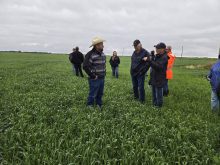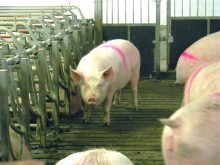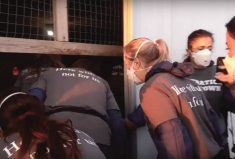“If you have sick pigs, they don’t eat.”
– Dr. Mike Sheridan
Pig producers would have fewer disease problems in their herds if they spent more time walking the pens and injecting visibly sick animals.
So says Dr. Mike Sheridan, one of Manitoba’s leading swine veterinarians.
Going into barns and actually treating sick animals is one of the most overlooked applications in herd health, Sher idan told the recent Manitoba Swine Seminar in Winnipeg.
Read Also

Mazergroup’s Bob Mazer dies
Mazergroup’s Bob Mazer, who helped grow his family’s company into a string of farm equipment dealerships and the main dealer for New Holland machinery in Saskatchewan and Manitoba, died July 6 from cancer.
It sounds so simple. But many producers prefer mass medicat ion – providing medicated feed – instead of going in, needling pigs and recording the treatment, Sheridan said.
Unfortunately, giving medicated feed to sick animals doesn’t always work.
“If you have sick pigs, they don’t eat. They’re not going to get the medication and they will not begin to recover,” Sheridan said following his presentation.
“They’ll drink longer than they’ll eat. But if they’re struggling to get to the water because they don’t feel very good, they won’t get water medication at the correct level. We recommend needling so they get the proper dose in a timely fashion and get the treatment completed.”
Timely treatment is also important from the standpoint of animal welfare. It ensures the animal is properly cared for, he said.
Sheridan said most producers are pretty savvy about spotting diseases and knowing which medication to give.
“If they treat and things don’t respond as they expect them to, then certainly we’re always there to come in and assist with getting a further diagnosis.”
Broken needles in pigs are a hog producer’s bugbear. Some prefer not to inject for fear of breaking the needle and having the carcass eventually condemned or downgraded.
But Sheridan said workers can be trained to do proper injections with the help of slapshots or plastic extensions.
If broken needles do occur, animals carrying them should be immediately identified and recorded, he said.
CQA, the on-farm food safety program for Canadian hog producers, has material on giving proper injections to pigs with instruction on needle sizes, dosages, techniques, etc.
Sher idan acknowledged there comes a time when it’s not economical to treat a pig, especially when producers are losing $20 to $30 on a market animal.
“When economics are poor, we try and euthanize as quickly as we can. (When economics are better), unless there’s something really life-threatening, like broken legs or some severe injuries they’re absolutely not going to recover from, we’ll go ahead and treat them. But we try to put a timeline on different diseases so that, at the end of a specific time, if an animal hasn’t responded properly, it gets euthanized.”
In his presentation on the proper use of antibiotics, Sheridan stressed giving drugs according to label directions. Provisions in Canada allow for off-label use but only with a prescription from a veterinarian familiar with the herd.
Off-label use constitutes differences in: usage, drugs not registered for use in pigs, route of administration, purpose of treatment, age group or stage of production.
Al tering the dose also means adjusting the withdrawal time to avoid drug residues in the carcass, said Sheridan.
He emphasized antibiotics are organic products. They can be damaged through improper handling, such as exposure to excessive heat, cold or light and by refrigerating drugs meant to remain at room temperature.


















